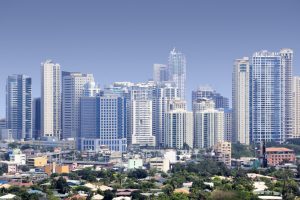As Ferdinand Marcos Jr. prepares to become the next president of the Philippines, now is an opportune moment to take stock of the economy and consider some of the challenges ahead. While there hasn’t been much detailed information about how he plans to manage the economy, Marcos will probably look to maintain a basic sense of continuity with his predecessor, Rodrigo Duterte. Despite high levels of inequality and poverty, the Philippine economy under Duterte has performed relatively well and helped buoy his popularity. Marcos no doubt hopes it will do the same for him.
After Duterte took office in 2016, in every year until the pandemic the economy grew at a rate of 6 percent or higher. Per capita national income increased by 30 percent from 2015 to 2019, and gross capital formation jumped from 21.3 percent of GDP to 26.4 percent over the same period. That generally indicates more investment activity is taking place, and under Duterte investment conditions have broadly improved, particularly for foreign capital. According to the central bank of the Philippines, net foreign direct investment increased dramatically in recent years, from around $100 million in 2015 to $5.3 billion by 2019.
Duterte’s government also responded to the pandemic reasonably well, at least from a macroeconomic point of view, running large fiscal deficits to shore up the healthcare system, inject stimulus and provide social assistance via a pair of big rescue packages. This prevented the economy from imploding and by the fourth quarter of 2021, gross national income at constant prices had bounced back to $103 billion, only slightly below where it was in the fourth quarter of 2019. Marcos in all likelihood would like to see this momentum consolidated and carried forward, with annual growth returning to a steady 6 percent or above, anchored by capital formation and FDI.
There is a lot of uncertainty in economic projections, but we can say with some confidence that this time it won’t be that easy, at least not right off the bat. The Philippines imports a lot more than it exports. Last year, its deficit in tradable goods alone was nearly $54 billion. That, too, is a legacy of the Duterte administration, under which imports accelerated significantly. This is typically offset to some degree by surpluses in service exports and inflows of income remitted from Filipinos living and working abroad. But even so, the Philippines ended 2021 with a deficit in its current account of more than $6 billion.
If these were ordinary times, it probably wouldn’t be a big deal. But Marcos will assume the presidency just as the U.S. Federal Reserve is hiking interest rates to cool off inflation, and this usually squeezes the currencies of countries running current account deficits. The Philippine peso has steadily lost value against the dollar since mid-2021, and that is likely to continue under current conditions. This will make imports more expensive when the economy is already struggling with inflationary pressure.
Another thing to consider is that the Philippines imports a lot of its energy. According to the Asian Development Bank, in 2019 this included 8.5 million tons of imported crude and 30.7 million tons of coal. A weakening peso and high global commodity prices will add upward pressure on the cost of gasoline and electricity at a time when inflation is already high. Meanwhile, because of the pandemic the government has been running sizable budget deficits, which reached 8.6 percent of GDP last year. That was the right thing to do given the circumstances, but it does impose a degree of fiscal constraint moving forward.
Marcos will take office during a time of overall high levels of inflation and monetary tightening in the global financial system. This will likely weaken the currency and make imports more expensive, especially commodities which the Philippines imports a lot of, such as crude and coal, driving up energy prices for consumers. There may also be some shifts in the way foreign capital in the global financial system is distributed, potentially making FDI scarcer than it was during Duterte’s presidency. Despite some fiscal constraints, there are ways to deal with these issues. All of them, however, will involve competent governance, sound policy-making and the ability to understand and weigh trade-offs. Whether the Marcos Jr. administration is up to that task will be one of the first big questions of his presidency.

































